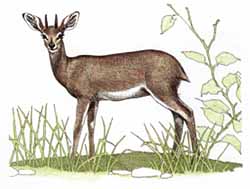English: Steenbuck; French: Steenbok, Raphicère; Afrikaans: Steenbok, Vlakbok; Damara: !aris, !airis; Herero: Ombuindja; Iswana: Chuduhudu; Kiswahili: Dondoro; Kung: !ton, g!ei, g!ai; !kai = ài, c’hu; Kwanyama: Omhundja; Lozi: Kabu; Maasai: Ol Bwansa; Ovambo: Ombundja; Shangan: Xipeni; Shona: Mhere; Sindebele: Nguina; Xhosa: Itshabanga; Zulu: Iligado.
 |
Former distribution: As now.
Present distribution: Southern and eastern Kenya, Tanzania; south-western Zambia, Zimbabwe, Mozambique, Botswana, southern Angola, Namibia and in South Africa in Transvaal, Natal, Orange Free State and the Cape Province.
Behaviour: Preferred habitat: open ground such as grassland – with scattered bushes or scrub; active diurnally and live singly or in pairs. Steenbucks both browse and graze leaves, plants, herbs and grasses. Predators include leopards, caracals, jackals, servals and pythons.
Population status: Stable.
Brief notes:
Body weight: 10-16 kg
Head and body length: 70-90 cm
Tail length: 5-10 cm
Shoulder height: 50-60 cm
Gestation period: 168-173 days
Maximum age: Probably 10-12 years
Trophy: Record SCI: 18 1/8 score, 1977 Namibia, PAUL E. ROBEY; average 11 score. RW’s: 7 1/2″, RSA, D. MACKINTOSH; average 4 1/2″.
Hunting methods: Stalking.
Subspecies: 8, acc. to ANSELL (1972) „a study of adequate series would probably lead to a reduction in the numbers of these subspecies.“
1. R.c. campestris (Southern and western Cape Province)
2. R.c. capricornis (Zimbabwe, Mozambique, Transvaal)
3. R.c. zuluensis (Northern Natal)
4. R.c. natalensis (Southern Natal)
5. R.c. fulvorubescens (Eastern Cape)
6. R.c. neumanni (Central Kenya, southern Tanzania)
7. R.c. steinhardi (Botswana and Namibia)
8. R.c. kelleni (Southern Angola)
Remarks: A revision of all these subspecies is overdue.






